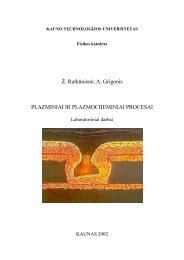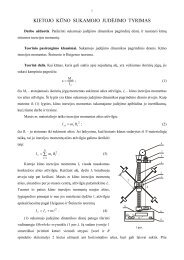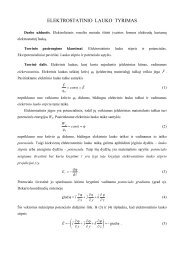PROCEEDINGS OF THE 7 INTERNATIONAL ... - Fizika
PROCEEDINGS OF THE 7 INTERNATIONAL ... - Fizika
PROCEEDINGS OF THE 7 INTERNATIONAL ... - Fizika
Create successful ePaper yourself
Turn your PDF publications into a flip-book with our unique Google optimized e-Paper software.
I. Cibulskaite et al. / Medical Physics in the Baltic States 7 (2009) 72 - 75<br />
DOSnrc (EGSnrc) [2] in each region of interest.<br />
Estimated relative statistical uncertainty of calculated<br />
doses was 0.8% in the case when 10 8 photon histories<br />
were taken for the simulation, and 0.2% - for 10 9 photon<br />
histories.<br />
The spectra of the X-ray beam, entered to the code<br />
system for interaction modelling, were generated for<br />
different X-ray tube potentials from the range of (25 -<br />
32) kV when the tilting angle of the Mo anode was 16 0 .<br />
Generated X-rays were attenuated by 1 mm Be window<br />
of the X-ray tube, 0.03 mm thick Mo filter and 3 mm<br />
thick polymethylmethacrilic compression paddle of<br />
mammography unit.<br />
Additional filtration of the photons with the energies<br />
below 10 keV and above 20 keV was undertaken due to<br />
the fact, that Mo is characterized by K lines at the<br />
energies: 17.38 keV (Kα2), 17.49 keV (Kα1), 19.61 keV<br />
(Kβ1) and 19.96 keV (Kβ2) [3]. X-ray photon spectra<br />
were calculated using IPEM Spectrum Processor [4] and<br />
average photon energies for the applied X-ray tubes<br />
potentials were estimated taking into account the special<br />
geometry of the irradiation.<br />
3. Results<br />
Adapted for specific geometry EGSnrc code was used<br />
for X-ray photon interaction with physical object<br />
modelling. The main characteristic that was chosen was<br />
radiation dose, that reflects information about energy<br />
transfer, absorption and scatter in every segment of the<br />
complex object irradiated by X-ray photons. The result<br />
of modelling are total and scatter doses in selected<br />
objects. It was considered that the total dose represents<br />
the energy, transferred to the target and the scatter dose<br />
is defined as a dose, which can be traced back to the<br />
photons that have been scattered in Compton and<br />
Rayleigh effects and to the photons that were created<br />
trough relaxation processes after Compton and<br />
photoelectric effect.<br />
Modelling of low energy (25-32) keV X-ray induced<br />
processes was performed for the constructions<br />
consisting of Si wafer (active volume) protected by<br />
different coating materials which are commonly used in<br />
radiation detector constructions. Some characteristics of<br />
the investigated coatings are provided in Table 1.<br />
X-ray interaction effects in the detector construction are<br />
dependent on X-ray attenuation and scattering processes<br />
in the coating material, which are influenced at least by<br />
the coating structure (polycrystalline, amorphous,<br />
polymer-like), coating density and thickness, and the<br />
construction of the layered structure (with or without<br />
chemical bonding between detector and coating<br />
material).<br />
A thin air gap existing between the coating and detector<br />
material was inserted into modelling geometry in the<br />
case of free standing polymeric foils. Nanothick<br />
interlayer structure between bulk material and coating<br />
was considered for the modelling of the structures<br />
73<br />
having direct deposited or grown coating layers on the<br />
top of the active volume.<br />
The thickness of Si target in investigated constructions<br />
varied within the range of 0.1 mm – 3.0 mm, the<br />
thickness of protective coatings was from the interval of<br />
100 nm - 1.0 mm.<br />
Table 1. Coating materials<br />
Coating<br />
type<br />
Coating material Zeff Density,<br />
g/cm 3<br />
Free Polyethylene<br />
5.68 0.93<br />
standing H – 14 %, C – 85 %<br />
polymeric<br />
foils<br />
Mylar,<br />
Polyethylenetereftalate<br />
H – 4 %, C – 62 %, O<br />
– 33 %<br />
6.71 1.38<br />
Rubber<br />
H – 11%, C – 88%<br />
5.75 0.92<br />
Carbon fibre 6.10 1.75<br />
Direct<br />
deposited<br />
/ grown<br />
layers<br />
SiO2<br />
DLC film synthesized<br />
from C2H2: H – (24 %<br />
11.5<br />
diverse<br />
2.32<br />
1.60<br />
2.12<br />
-<br />
to 38%)<br />
SiOx-containing DLC<br />
film, synthesized from<br />
HMDSO:<br />
main components, O<br />
and<br />
Si (17% - 24%)<br />
diverse 1.87 -<br />
2.20<br />
Comparing the modelling results, radiation induced<br />
scatter dose of X-ray photons was higher in all coated Si<br />
specimens of different thickness, as compared to<br />
uncoated ones, while the total dose was less, due to the<br />
photon energy absorption in coating material. Increasing<br />
for scatter dose and decreasing for the total dose<br />
tendency was observed with the increasing density of<br />
coating material within the whole energy range of<br />
mammography examinations, when the thickness of<br />
coating was kept constant.<br />
Some variations of calculated scatter doses in Si targets<br />
of different thickness coated by different coating<br />
materials of the same thickness, representing results of<br />
the investigation are shown in Fig. 1. Lines in this figure<br />
indicate the highest and lowest scatter doses<br />
corresponding to the coating material, which were<br />
evaluated within the group of coated samples, having<br />
the same Si target thickness. A broadening of the range<br />
between the highest and lowest scatter dose within the<br />
group indicates the influence of coating material<br />
(increased density) on scatter dose in coated Si when the<br />
thickness of the active Si volume is decreased. The<br />
highest scatter dose was estimated for Si-DLC film<br />
containing SiOx combination, which represented the<br />
highest density (2.2 kg/m 3 ) of all investigated coatings.<br />
Scatter doses calculated for Si coated by nanothick DLC<br />
film were included in Fig 1 for the comparison of the<br />
results.








